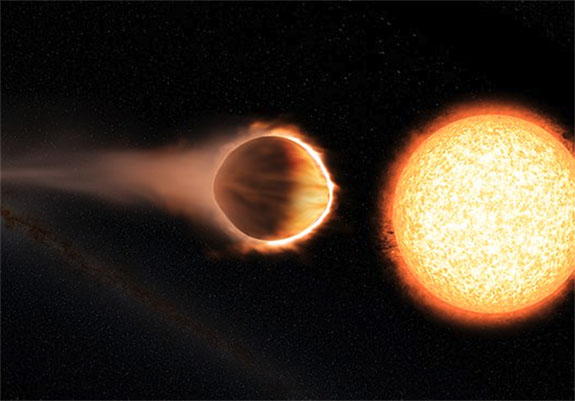Rubies, Sapphires Are Raining Down on Scorched Exoplanet WASP-121b
As a record-breaking Arctic blast blankets the US heartland with ice and snow, it's raining liquid sapphires and rubies on the heavy metal exoplanet called WASP-121b, where temperatures regularly soar to 4,700 degrees Celsius (8,492 degrees Fahrenheit).

A team of astronomers led by European Space Agency research fellow Quentin Changeat analyzed three years of data collected by the Hubble Space Telescope and concluded that WASP-121b's turbulent atmosphere provides a perfect environment for precious stone precipitation.
Located 880 light-years from Earth in the constellation Puppis, the exoplanet WASP-121b is so close to its host star that it can complete its orbit in just 30 hours. Because it is tidally locked, the day side of the exoplanet always faces the blazing hot star and the night side (730 degrees Celsius, 1,346 degrees Fahrenheit) always faces out into space.
The extreme 4,000-degree temperature difference between the two hemispheres gives rise to strong winds that sweep around the entire planet from west to east at 18,000 kilometers per hour. The winds blow vaporized metals from WASP-121b’s torched dayside to its relatively cooler (but still brutally hot) nightside. The temperature change allows the metals to condense into clouds, resulting in rain that might look like liquified iron and gemstones.
The three-year deep dive into the archival weather data enabled Changeat's team to reconstruct WASP-121b's changing atmosphere and weather in a way that had never been accomplished for a planet outside the solar system, according to advancedsciencenews.com.
“Those supercomputer models helped discover a new storm-generation mechanism where multiple cyclones are repeatedly generated and destroyed,” Changeat told the science website.
According to NASA, WASP-121b is a doomed exoplanet. It's nearly twice the size of Jupiter, but is orbiting so close to its parent star that it is literally being torn apart. Gravity causes enormous tidal forces, which are stretching the planet into the shape of an egg. The star’s gravity also pulls material off the planet into a disk around the star. In 10 million years, predicts NASA, this alien world could be completely consumed.
“We were surprised by how extreme the conditions on ultra-hot Jupiters can be,” Changeat told advancedsciencenews.com. “While storms and other extreme phenomena are common on the Earth and solar system planets, it is much more impressive on ultra-hot Jupiters where storms the size of the Earth can easily be generated.”
Credit: Illustration by NASA, Public domain, via Wikimedia Commons.

A team of astronomers led by European Space Agency research fellow Quentin Changeat analyzed three years of data collected by the Hubble Space Telescope and concluded that WASP-121b's turbulent atmosphere provides a perfect environment for precious stone precipitation.
Located 880 light-years from Earth in the constellation Puppis, the exoplanet WASP-121b is so close to its host star that it can complete its orbit in just 30 hours. Because it is tidally locked, the day side of the exoplanet always faces the blazing hot star and the night side (730 degrees Celsius, 1,346 degrees Fahrenheit) always faces out into space.
The extreme 4,000-degree temperature difference between the two hemispheres gives rise to strong winds that sweep around the entire planet from west to east at 18,000 kilometers per hour. The winds blow vaporized metals from WASP-121b’s torched dayside to its relatively cooler (but still brutally hot) nightside. The temperature change allows the metals to condense into clouds, resulting in rain that might look like liquified iron and gemstones.
The three-year deep dive into the archival weather data enabled Changeat's team to reconstruct WASP-121b's changing atmosphere and weather in a way that had never been accomplished for a planet outside the solar system, according to advancedsciencenews.com.
“Those supercomputer models helped discover a new storm-generation mechanism where multiple cyclones are repeatedly generated and destroyed,” Changeat told the science website.
According to NASA, WASP-121b is a doomed exoplanet. It's nearly twice the size of Jupiter, but is orbiting so close to its parent star that it is literally being torn apart. Gravity causes enormous tidal forces, which are stretching the planet into the shape of an egg. The star’s gravity also pulls material off the planet into a disk around the star. In 10 million years, predicts NASA, this alien world could be completely consumed.
“We were surprised by how extreme the conditions on ultra-hot Jupiters can be,” Changeat told advancedsciencenews.com. “While storms and other extreme phenomena are common on the Earth and solar system planets, it is much more impressive on ultra-hot Jupiters where storms the size of the Earth can easily be generated.”
Credit: Illustration by NASA, Public domain, via Wikimedia Commons.

